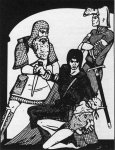Alignment is action-movie morality: it's okay to kill the bad guys because they're bad, now get on with the action. Aaron pointed out some good canonical examples above, and there are plenty of others.
No, its not. It never has been, and never will be. Alignment has never ever been described in those terms (barring some random quote by Gygax that gets bandied about every now and then, which is nothing more than a statement on his own views on aligment).
Certainly since 3E at the very least, killing, harming and opressing others = Evil. Mercy, compassion and kindess = Good.
I have to agree with you both here.
Alignment isn't described in those terms. But the game has an understood morality that is presented as being based on a good vs evil.
But evil is defined quite differently than our world. The game presents things like goblins and orcs as inherently evil, and they exist purely for the PCs to kill. But it goes further than even that, lycanthropes, for example, which are evil creatures, but in many cases evil only when in their monstrous form. Yes there are good creatures in the MM, not everything there is just to kill. But the evil creatures are presented as eligible for PCs to kill without any moral questions at all.
Moving to the adventures, and even human or "good" humanoid races are presented in the same light. The Cult of the Dragon in HotDQ/RoT, the Elemental Cults of PotA, etc. Members of those organizations are presented in the same way.
So killing isn't always evil. And had the description of the scene in the OP been that they had tracked down the leader of the Cult of the Dragon into a bar, a fight ensued, and he surrendered, but they killed him anyway? Still probably leaning evil, but an entirely different scenario.
Regardless of whether Lord of the Rings was written in response to real-world wars, the orcs in the story form a very good parallel with the Nazis. Everybody who watches an Indiana Jones films knows the Nazis are bad, and it's OK to kill them.
Star Wars has the same morality, and the questions about the greater good and such still lean very heavily to allow only killing in self-defense, or in a war-like situation.
Killing Dooku who was surrendering? Evil.
Killing sand people in what might be considered a crime of passion when your mother dies? Evil.
The whole story arc of Anakin in the prequels is more or less a study on changing alignment from a D&D perspective.
But killing storm troopers, even those that aren't actively attacking you is OK if you're on a mission.
The reality is, morality, especially in regards to killing, tomb robbing, and theft, are drawn as black and white to keep moral quandaries from bogging down the game. DMs can take that and blur the lines, which I think makes things much more interesting. As I mentioned before, the inclusion of non-combatants (civilians) of "women and children" in Caves of Chaos is one of those. Most groups see them as just more stuff to kill.
But it can also be used by the players in character development, questioning their own morality and the morality of the world. This can be very interesting. But some (most?) groups just want to kill stuff for treasure and more power and abilities.
The game also has a history of attempting define an individuals morality within that framework with alignment. Alignment doesn't define the morality, it defines or describes how a character fits within that morality. Early editions went so far as to restrict what you could get away with within that alignment by penalizing you for changing alignment, to the point of permanently losing all special abilities to certain classes if you changed it, or even if it were changed by an external force, such as magic (although then you might have a chance of regaining your abilities through a quest).
The morality projected is interesting, because assassins had to be evil. No lawful neutral, which is where I would put somebody like James Bond.
But within this context (in AD&D), Paladins lose their abilities whenever they "knowingly and willingly commit an evil act." Yet there is never a (published) question as to whether slaying scores of goblins, including women and children, is evil.
In part, the question of morality is present enough that it could become a central theme in a campaign, such as a Paladin losing their abilities due to a spell, and attempting to redeem themselves and regain their abilities.
Having a meaningful discussion regarding the original post, or even a wider discussion on what's good or evil in D&D is much more difficult if we don't agree on the framework. If you're running a campaign in a post-apocalyptic world - Dark Sun, Mad Max, something of that nature - then the moral questions are quite different.
In the situation described, though, it's a pretty standard fare D&D. The PCs in the tavern, and a bar fight breaks out. No indication that there is a suspicion that the bouncer is a mass murderer, etc. No imminent risk to the PCs or other people at the moment the killing took place. I definitely consider that frontier (think old west) law prevails. If the bouncer had started attacking other people, and the PCs were defending them and killed the bouncer, then that's OK. In the midst of battle, sure. If it was an orc that joined the fray (and not a bouncer), that would also fit the D&D morality as not evil, although it would be pushing things a bit if they surrendered. But there's a pretty good chance that if it was an orc and the PCs didn't kill the surrendering orc, that somebody else would.
But this was not an orc, not attacking, not armed, and surrendering.

